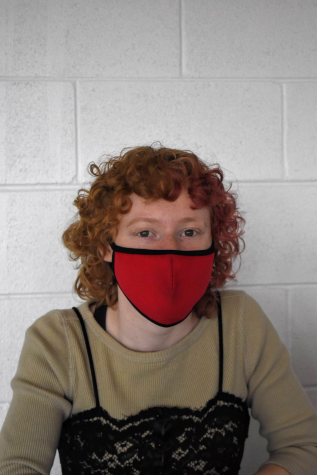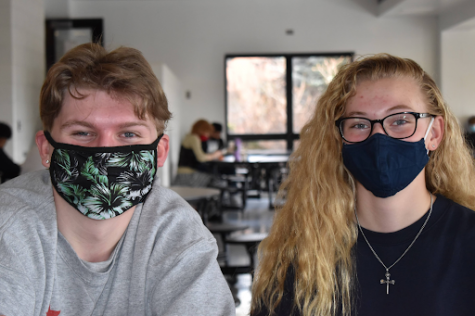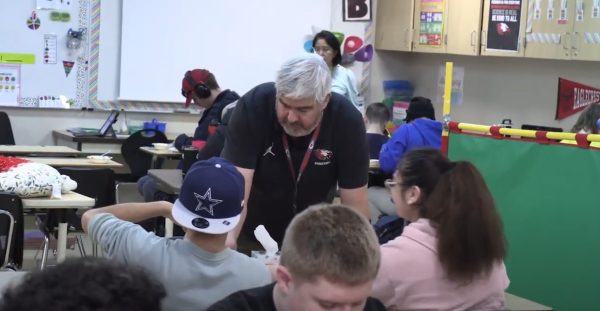6 Feet to 6 Inches
It’s finally time to meet the other half of the school.
On March 13th of 2020, coincidentally a Friday, many schools across the district and worldwide closed their doors for Spring Break – and ended up keeping them closed for the majority of another year.
Until April 5th of 2021, Eaglecrest separated its students by last name to prevent the spread of the virus and uncomplicate contact tracing. There were on and off moments during the school year: times we sat bored and lonely at home, and times we’d go to school only to receive half the high school experience.
There were times we didn’t go to school at all and instead, connected (but not really) through a blue-light screen. And for some, that was perfectly fine. “We might as well finish the year how we were doing it because the way we were doing it was working for almost everyone,” said senior Owen Campbell.
“I think it’s kind of useless that they chose right at the end to make us go back in person, just because we’re so used to a schedule and then automatically get it changed to an even more hectic and potentially dangerous schedule,” Campbell voiced.
In some cases, it’s not a matter of school itself, it’s a matter of getting up every morning. “Personally, I just feel more exhausted than usual because I’m not used to the whole five days,” said Brett Gutho, sophomore. A few months ago, going to school twice a week meant you were lacking face to face interaction and education, but it also meant that you weren’t seeing half of the school- the vital connection that makes high school what it is.
“It’s nice to have that social interaction again, but then there’s also that fear of the unknown,” said Campbell. “There’s anxiety in every aspect of it, it doesn’t matter if it’s the social or non-social part, there’s anxiety for both parties.”

Many are more concerned about the still raging global pandemic, despite the increasing availability of vaccines for ages 16 and older. “I really don’t like the one way hallways and I feel like they don’t really do a lot,” remarked senior Brittany Weeks. “When we’re walking through the breezeways especially, we’re all right next to each other anyways, and I feel like it would be just the same if we weren’t doing one way hallways.”
To many student’s delight, Principal Hansen-Vigil made the decision to lift one way hallways in accommodation to the CDC’s new guidelines. Starting May 6th, no longer would students have to walk all the way around the school for their next classes. Entrances and exits were opened to all students at 8:00. Many students still have cause for worry, however.
Much of Eaglecrest’s student body has been or knows someone that has been quarantined, sparking at least a little worry. “I know there are a lot of kids being quarantined still, and a lot of my friends have gotten emails saying they had someone in their class and they have to quarantine too,” said Mia Alexander, senior.
Being separated for reasons of safety was frustrating – and you could feel it. There was a quiet air hovering around half the school’s students, a noticeable difference materializing when the other half joined. And so it became safe to come back to school fully. We worked our way from full-online to hybrid to 5 days a week. But sometimes it’s just the Mondays that are off-putting.
“All the classes on Monday for 40 minutes kind of seems pointless cause we don’t even do anything in those classes,” said Paige Helfrich, a freshman. Despite the understanding that the days of the week should be evened out, it’s tiring to walk about the school, many to eight classes a day.
Others really appreciated being back in-person full time, considering both the social and academic aspects. “I like seeing my friends and the other cohort,” said Alexander. “It’s keeping me more in check so I can’t procrastinate as much.” Workloads have changed, with students now able to spend more time with their teachers and less time at home.

“It’s actually kind of worsened my grades because I’ve had less time. The days that you didn’t go [in person] were times where you were actually able to work on the assignments you were given and now you’re just constantly getting… assignments,” continued Campbell. “More expectations for less production time.”
Speaking of more expectations, some changes took some getting used to. “For most classes it’s okay, but for a lot of them it’s kind of stressful because the way we’re learning it is different and it’s harder for me to understand it,” said Weeks. Teaching styles had to be adjusted and accommodated to, and so did student attitudes.
“I think that a lot of the teachers and students just have different attitudes,” said Campbell. “Years before, there was a little more care-freeness, and now there’s a lot more expectation for a specific procedure when before, you were able to bend outside the rules. And that might’ve been the most confusing ever.”
The hallways: crowded. The classrooms: less awkward. The air: kind of stuffy. But normalcy is starting to return, and with it- the spirit of a semi-normal school year.






